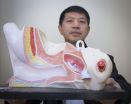(Press-News.org) While human activities have caused extinctions across the globe, your favourite beach or diving site may actually be home to as many, or more, species then it was a few decades ago.
That's the conclusion of a synthesis of 50 years of marine biodiversity data conducted by University of British Columbia (UBC) researchers.
But there is a catch. Like other studies of its kind, the synthesis relies on species population time series from sites that haven't been subject to intense human development.
"Much as you'd expect, our study shows human impacts like pollution and sedimentation were related to diminishing biodiversity in sites near developed areas," says UBC ecologist Robin Elahi, lead author of the study published today in Current Biology.
"But on the bright side, species gains were associated with sites that are protected or actively restored. To understand global patterns in local biodiversity change, it really helps to consider ecological neighborhoods case by case, because we have limited data."
The study reviewed trends in scientific report and fisheries data from 1962 to 2015 from 189 sites around the globe.
The vast majority of the study sites are located on coasts far from urban development. In 17 per cent of cases, sites reside in ecologically protected areas. It's a large proportion considering only three percent of the world's oceans are protected.
The synthesis indicates that even sites minimally impacted by human development saw increases in species lower in the food-web, like invertebrate suspension feeders. Those type of gains are consistent with species introductions, as well as the spread of previously uncommon species due to climate-driven range shifts.
"Although our study focused on changes in the raw numbers of species, it's clear that the types and composition of the species matters greatly, from an ecological and a human perspective," says Elahi.
According to the researchers, the synthesis highlights the need for more systematic and comprehensive biodiversity monitoring to improve protection and management efforts.
"At the local level, biodiversity studies could be over-sampling well-preserved sites that don't immediately correlate with the loss of species we know is occurring globally," says UBC Assistant Professor Mary O'Connor, co-author on the paper.
INFORMATION:
A study to examine recessively inherited genome-wide DNA sequences has for the first time discovered a potential link with Britain's biggest killer - Coronary Artery Disease (CAD).
The research led by a team from the University of Leicester was the first time that recessively inherited DNA sequences in the whole genome called Runs of homozygosity (ROHs) were examined for a connection to the disease.
The study appears in the American Journal of Human Genetics.
CAD is a terminal clinical manifestation of cardiovascular disease and is the leading cause of death worldwide ...
Danish researchers are the first in the world to have used our genes to investigate the impact of coffee on the body. The new study shows that coffee neither increases nor decreases the risk of lifestyle diseases.
We love coffee - and we drink a lot of it. New research from the University of Copenhagen and Herlev and Gentofte Hospital shows that coffee neither increases nor decreases the risk of developing lifestyle diseases such as obesity and diabetes. The researchers have based their study on genes, as our genes play a role in how much coffee we drink in the course ...
DENVER (July 9, 2015) - A new study from the University of Colorado Denver finds that male exotic dancers, or strippers, remain committed to stripping because it enhances their self-concept.
The study by Maren Scull, an instructor of Sociology in the CU Denver College of Liberal Arts and Sciences, was published online this month in Deviant Behavior, the only scientific journal that specifically addresses behaviors that violate social norms. Scull's research focuses on how exotic dancing influences the way male strippers view themselves.
"Because stripping is a stigmatizing ...
This news release is available in French.
Since the treatment has become available, HIV is often described as "undetectable" and the risk of transmission has been drastically reduced. However, the epidemic is still quite present in the lives of many gay and bisexual men... and in public spaces. This often overlooked dimension of the disease has been brought to light by Gabriel Girard of the University of Montreal's Public Health Research Institute (IRSPUM) - HIV is still alive in the city, especially in the Village, Montreal's gay district. "Urban traces are significant ...
WEST LAFAYETTE, Ind. -- A key set of immune cells that protect the body from infection would be lost without directions provided by vitamin A, according to a recent study.
A team of researchers from Purdue University found retinoic acid, a metabolite that comes from digested vitamin A, is necessary for two of the three types of innate immune cells that reside in the intestine to find their proper place.
"It is known that vitamin A deficiencies lead to increased susceptibility to disease and low concentrations of immune cells in the mucosal barrier that lines the intestines," ...
MADISON, Wis. -- A study authored by two University of Wisconsin-Madison graduate students indicates that while playing video games can improve mood, violent games may increase aggressive outcomes.
The study, authored by James Alex Bonus and Alanna Peebles, graduate students in Communication Arts, and Karyn Riddle, assistant professor in the School of Journalism and Mass Communication, was published in June in the journal Computers in Human Behavior. The researchers looked at how video games may be used to manage emotions -- specifically, whether playing the games can ...
(Edmonton) Screening newborn babies who are in the neonatal intensive care unit (NICU) using a testing process called high-frequency tympanometry can help identify middle-ear problems earlier, according to newly published research from a local team of researchers.
"If people cannot hear, we need to know if the problem is with the middle ear, inner ear or hearing nerve. Obviously, a baby cannot tell you, so in the clinic it's hard to know when they have hearing loss," explained Ming Zhang, an associate professor at the U of A's Department of Communication Sciences and ...
The relationship between mental and physical health is well established. But when mental and physical illnesses co-occur, patients' accounts of physical illness are sometimes arbitrarily discredited or dismissed by physicians.
Research by Jeremy D. Coplan, MD, professor of psychiatry at SUNY Downstate Medical Center, and colleagues has documented a high rate of association between panic disorder and four domains of physical illness. The research could alter how physicians and psychiatrists view the boundaries within and between psychiatric and medical disorders.
"Patients ...
Green buildings are indeed healthy buildings. So says Dr. Joseph Allen and fellow researchers of the Harvard T.H. Chan School of Public Health in the US. They conducted the first comprehensive review of studies that focused on green buildings and summarized the health benefits for the people who work and live in them. The review is published in Springer's journal Current Environmental Health Reports.
The green building movement has taken off in the past 10 years. According to Leadership in Energy and Environmental Design (LEED®), which certifies green building standards, ...
In about one-sixth of the cases of male infertility, men do not make any measurable levels of sperm, a condition called azoospermia. New research led by University of Pennsylvania scientists suggests that mutations in an X chromosome gene called TEX11 are responsible for about 1 percent of azoospermia cases.
The investigators also found that in mice bred to lack the gene, reintroducing the gene restores their fertility. Additional studies in mice revealed that a certain amount of the TEX11 protein expressed from the gene is needed for sperm to form. The protein plays ...




